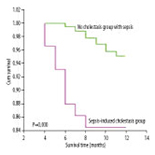Sepsis-Induced Cholestasis is Associated with Increased Rates of Complications and 1-Year Mortality in Patients with Liver Cirrhosis
Juan-Juan Wu, He-Bin Fan, Ya-Bing Guo, Dong-Liang Yang, Chang-Li Zhang, Jun Xiao, Jie Sun, Lu Huang, Zhi Li, Li-Tong Xu, Fu-Ming Yan
Med Sci Tech 2016; 57:116-121
DOI: 10.12659/MST.902027
Available online: 2016-12-23
Published: 2016-12-23

BACKGROUND:
Patients with liver cirrhosis are prone to bacterial infection. However, the occurrence of sepsis-induced cholestasis in cirrhotic patients has been seldom reported. The objectives of this study were to investigate sepsis-induced cholestasis in liver cirrhosis and its correlation with complications and short-term mortality.
MATERIAL AND METHODS:
We screened 1028 consecutive patients with liver cirrhosis for cholestasis. Cholestasis was defined as total plasma bilirubin levels >3 mg/dL.
RESULTS:
Of the 704 patients meeting the inclusion criteria, 134 patients (21.3%) developed cholestasis. The control group consisted of 570 patients who had sepsis but did not develop cholestasis. Of the 134 patients who developed cholestasis, sepsis was a major factor (n=58, 43.3%). Other causes of cholestasis included viral hepatitis (n=42, 31.3%), drug hepatotoxicity (n=23, 17.2%), and unknown reasons (n=11, 8.2% p=0.000). Among them, one-year mortality rate was significantly higher in the sepsis-induced cholestasis group compared to the control group (15.5% vs. 4.9%, p=0.000). Eighteen (31%) patients with sepsis-induced cholestasis developed at least 1 complication, as compared to 57 (10%) patients in the control group (P=0.021).
CONCLUSIONS:
Sepsis was a major cause of cholestasis. Since cholestasis per se contributes to hepatic encephalopathy, as well as renal and GI complications; prevention and treatment of infection could reduce the development of complications and the death rate in patients with liver cirrhosis.
Keywords: Cholestasis, Liver Cirrhosis, Sepsis



